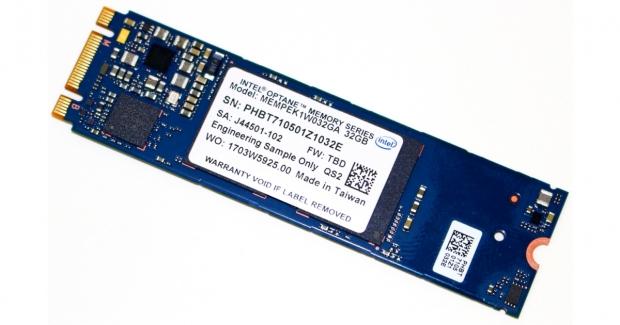
The Bottom Line
Introduction, Drive Specifications, Pricing & Availability

Caching is back. Our first in-house hands-on with Optane comes in the form of Intel's Optane Memory modules. Optane Memory is a low cost - small capacity (16 or 32GB) PCIe Gen3x2 Single sided 3D XPoint-based M.2 x 2280 caching SSD designed to accelerate high-capacity SATA-based storage. The Intel Optane Memory module is a system accelerator that learns and adjusts to your computing tasks - greatly enhancing the user experience by accelerating frequent tasks such as booting your PC, launching programs and web browsers.
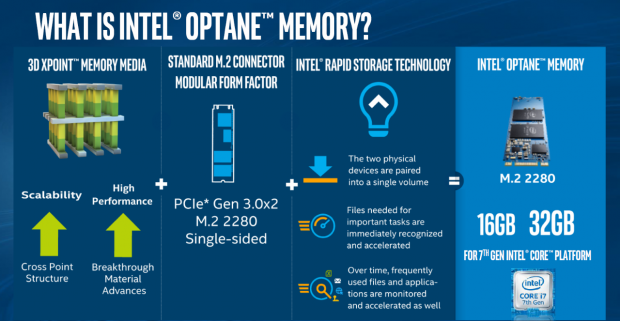
Optane memory modules are designed to operate in conjunction with Intel 200 Series motherboards, 7th Gen Intel Core i7 "Kaby Lake" processors and Intel's Rapid Storage Technology (IRST) driver version 15.5 or higher. Pairing Optane Memory with a mechanical HDD gives you the best of both worlds - extreme high capacity at a low cost per terabyte and blazing fast system performance. If you want even better overall system performance, you can pair Optane Memory with a high-capacity SATA SSD and eliminate the SATA interface read bottleneck.
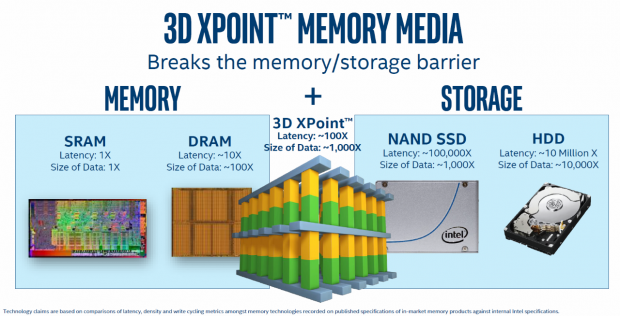
What is Optane? Intel calls their 3D XPoint technology "Optane." Optane consists of 3D XPoint memory, Intel memory and storage controllers, Intel interconnect IP and Intel software. 3D XPoint memory is a joint venture between Intel and Micron (IMFT). The actual IP outside of the memory itself is separate proprietary technology. On a cellular level, 3D XPoint is 1000x faster than NAND flash memory. In the real-world, actual performance is limited by bus performance, so you won't be getting 1000x faster performance than NAND Flash based SSDs can deliver.
When evaluating SSDs for purchase, people tend to focus on sequential performance as the primary indicator of how fast an SSD will perform. Over the year's buyers have been trained to look at sequential performance because that is the way NAND Flash SSDs have been marketed. Sequential performance is important if you are using the SSD to transfer files quickly. However, most users will be installing operating systems on their SSDs to obtain the best OS performance and not using them for transferring huge files from one SSD to another. What really matters in an OS environment is what we've been harping on for years – low queue depth random read performance, and this is what Optane brings to the table in game-changing fashion.
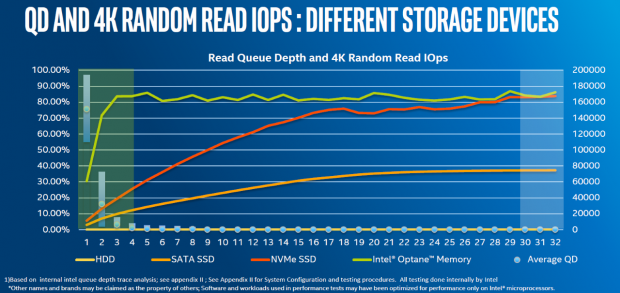
Random read performance at low queue depths is where conventional flash-based SSDs are at their weakest and where performance matters most. Optane Memory delivers 5-8x the random performance of flash-based SSDs at queue depths of 1-4. In fact, as the above graph illustrates, Optane Memory is essentially delivering full performance at QD3. This is why we are calling Optane Memory a game changer.
In an OS environment, almost all read transactions are random and occur at QD1 or QD2. Random reads will typically be 70% of the overall transactions executed when you use your computer, and as such, it is by far the most important performance metric. 75% of random read transactions occur at QD1, and as illustrated above, the difference between SATA SSDs and flash based NVMe SSDs at QD1 is minimal at best. This is why for the most part, you cannot visibly differentiate the difference between a PC that is running an OS on a SATA-based SDD or one running on an NVMe flash-based SSD. They both boot just as fast, and deliver virtually the same user experience as one-another.
As we dive into this review, we want to point out a few things that will be different with this review than our normal review protocol. Optane Memory is a new type of memory media. It is a very small capacity SSD that is intended to be utilized as a system accelerator. Therefore, we don't have any apples-to-apples comparisons from the past. With this in mind, we will not be providing comparison charts for every benchmark. We will be primarily utilizing benchmark screenshots to illustrate the system performance Optane Memory can deliver. We will be benching with four different configurations utilizing two different systems for each benchmark unless it is not feasible to do so. We will demonstrate how the base system that Intel provided performs with the mechanical HDD running on its own. How the base system runs with the mechanical HDD with Optane Memory acceleration. How the Optane Memory module performs on the base system as a standalone device. And, finally how Optane Memory performs on TweakTown's powerful brand spanking new Z270 test system running as our OS Disk.
Our approach is intended to not only highlight how Optane Memory runs as a system accelerator but to also explore the potential of 3D XPoint as a stand-alone storage medium. It is very important to keep in mind that the Optane Memory module we are testing is ultra-small in capacity, has only 2-lanes of PCIe Gen3 x4 for the interface, a tiny two channel controller and only two 16GB media die. It is very low spec'd in comparison to current NVMe flash-based SSDs. However, even with all these apparent disadvantages, Optane Memory is by far the most responsive and highest performing SSD, in terms of random read performance, we've ever tested.
Specifications

Intel's M.2 x 2280 single sided Optane Memory module is available in two capacities: 16GB and 32GB. The 32GB module we have on the bench today sports the following specifications:
- Sequential Read: up to 1,350 MB/s
- Sequential Write: up to 290 MB/s
- Max 4K Random Read Speed: up to 240,000 IOPS
- Max 4K Random Write Speed: up to 65,000 IOPS
- Latency - Read: 9us
- Latency - Write: 30us
- Power - Active: 3.5 Watts
- Power - Idle: 1 Watt
- Endurance: up to 182.5 TBW
- MTBF: 1.6 Million Hours
- UBER: < 1sector per 10^15 bits read
- Reliability feature: End-to-End Data Protection
- Warranty: 5-Year Limited Warranty
The 16GB model is set to retail for $44, the 32GB model $77.
Drive Details
Intel 32GB M.2 x 2280 Optane Memory Module
We did not get any retail packaging with the Intel Optane Memory module. The SSD came pre-installed on the provided test system with no packaging included. If you are interested, you can look at the spec sheet we provided, and there is an image of what the packaging will presumably look like.
We will not be removing the factory label because it has a copper layer inside of it. Removing thermal labels is never a good idea because they bend when removed and will never again lay flat over the components as intended. We will just be providing a photo of the front and back of the module.

This side of the module's blue PCB houses the drives 2-channel ASIC controller, two 16GB Optane Memory packages and various surface mounted components.

This side of the memory module is devoid of components. There is a label, which as shipped to us, is blacked out so it cannot be read.
Intel believes in this product and here is what they claim Optane Memory can do for you.
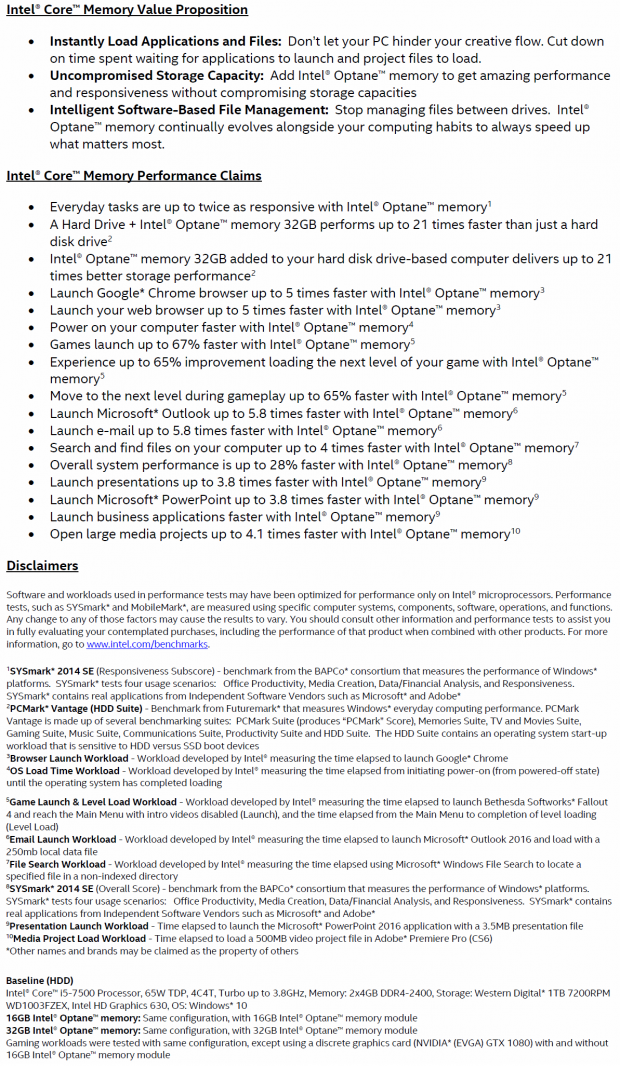
Test System Setup, Optane Memory Setup & Boot Videos
Jon's Consumer PCIe SSD Intel Z270 Review Test System - Specifications
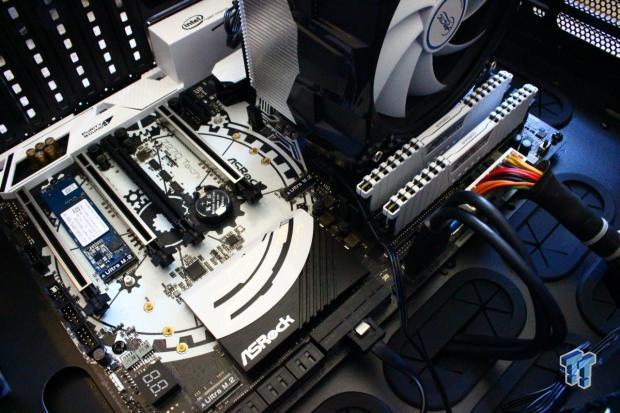
We want to give Corsair many thanks for providing the awesome white colored memory kit for our test system. As you can see, it complements the ASRock Taichi motherboard's color scheme quite nicely.
- Motherboard: ASRock Z270 Taichi - Buy from Amazon
- CPU: Intel Core i7 7700K @ 5.0GHz - Buy from Amazon / Read our review
- Cooler: Arctic i30 Freezer air cooler
- Memory: Corsair Vengeance LPX DDR4 16GB 3000MHz - Buy from Amazon
- Video Card: Onboard Video
- Case: Corsair Carbide Air 540 - Buy from Amazon / Read our review
- Power Supply: Seasonic Platinum 1000 Watt Modular - Buy from Amazon / Read our review
- OS: Microsoft Windows 10 Professional 64-bit - Buy from Amazon
Test system provided by Intel - Specifications
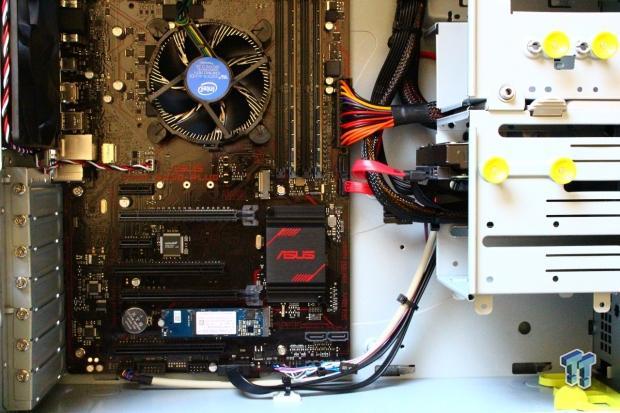
- Motherboard: ASUS PRIME B250-PRO
- CPU: Intel Core i5-7500
- Cooler: Intel inbox air cooler
- Memory: 16GB DDR4 - 2400
- Video Card: Onboard Video
- Case: InWin Mid-Tower
- Power Supply: 550 Watt Modular
- OS: Microsoft Windows 10 Professional 64-bit
We would like to thank ASRock, Crucial, Intel, Corsair, RamCity, IN WIN, and Seasonic for making our test system possible.
System settings: Cstates and Speed stepping are both disabled in our systems BIOS. Windows High-Performance power plan is enabled. Windows write caching is enabled, and Windows buffer flushing is disabled. We are utilizing Windows 10 Pro 64-bit OS (Build 14393) for all of our testing except for our MOP (Maxed-Out Performance) benchmarks where we switch to Windows Server 2012 R2 64-bit.
Intel sent along some benchmarks to test Optane Memory's responsiveness when launching programs and web browsers. We are not going to run those because we don't feel that those benchmarks show us anything meaningful than cannot be discerned adequately from our typical benchmarks. Intel's Optane Memory module is the most responsive SSD we've ever tested, and we feel that our testing will demonstrate this better than any of those types of tests will. We firmly believe that the ultimate evaluation for any storage device the user experience we get while running the device as our OS disk and that's one of the ways we will be testing Optane Memory today.
Enabling Optane Memory
Step one for enabling Optane memory is to download the latest Intel RST Driver with Optane Memory support. You can grab it here.
We are using Optane Memory to accelerate a 1TB WD Black mechanical HDD for low-cost, high-capacity storage and amazing system responsiveness.
After installing, open the Optane Memory control panel.
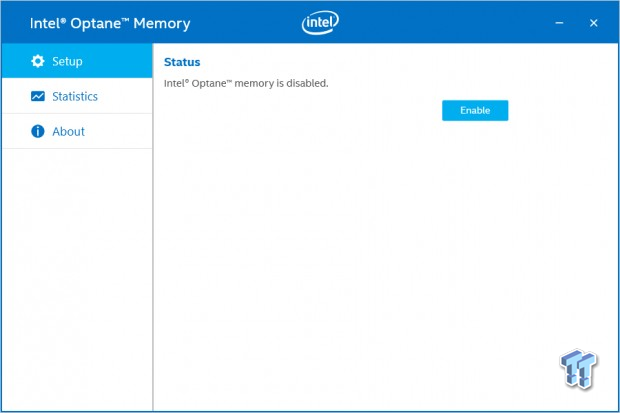
Click "Enable."
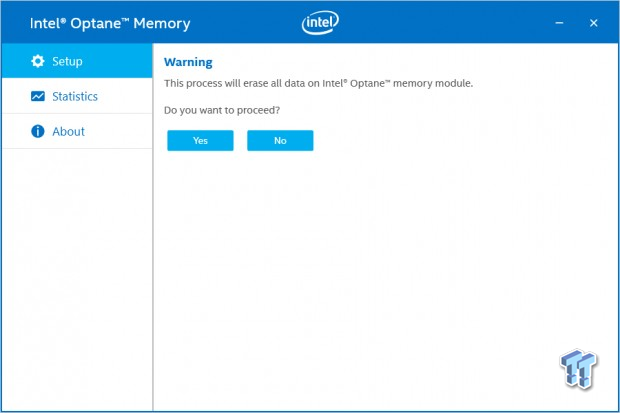
Click "Yes."
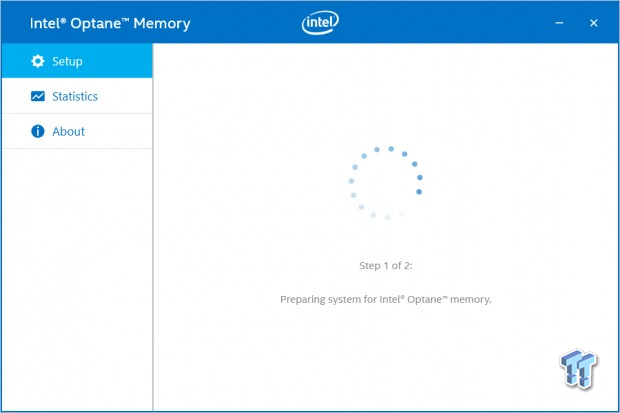
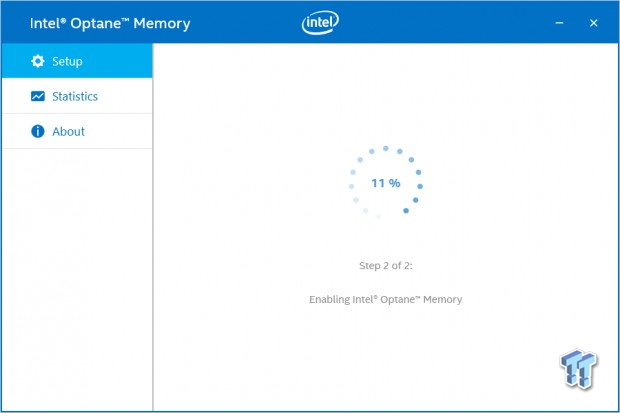
The Optane software begins the two-step process of enabling Optane Memory as a caching device for our mechanical HDD.
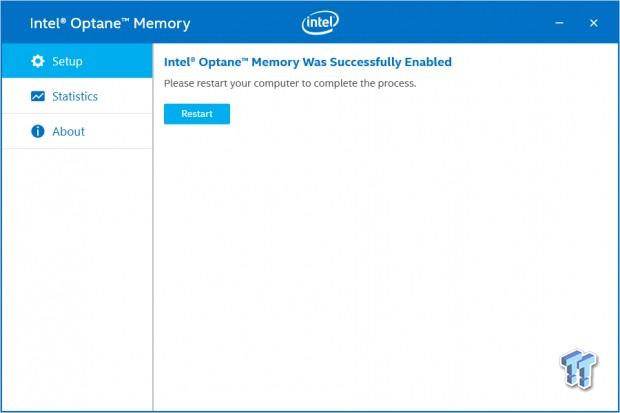
A restart is required after enabling Optane Memory.
Boot Speed (Restart to Desktop) - Videos
1TB WD Black mechanical HDD without Optane Memory on the system provided by Intel:
Restart time to desktop = 50 seconds. You can take the kids to school in the time it takes to boot a mechanical HDD.
1TB WD Black mechanical HDD + Optane Memory on the system provided by Intel:
Restart time to desktop = 14 seconds. Blazing fast with Optane Memory + HDD.
Optane Memory running as our OS Disk on TweakTown's Z270 SSD testing system:
Restart time to desktop = 10.5 seconds. Warp speed, Mr. Sulu.
Synthetic Benchmarks - ATTO & Anvil Storage Utilities
ATTO
Version and / or Patch Used: 3.05
ATTO is a timeless benchmark used to provide manufacturers with data used for marketing storage products. When evaluating ATTO performance, we focus on the drive's sequential performance.
Mechanical HDD only - Intel provided test system:
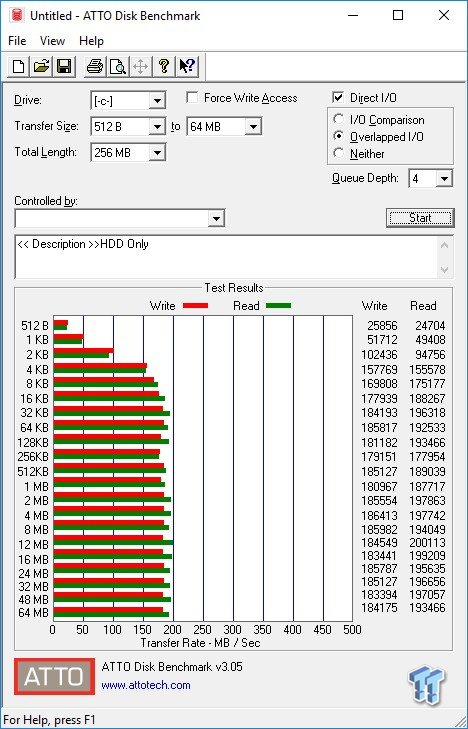
The mechanical HDD that was provided with the test system delivers 185MBs max sequential write performance and 200MBs max sequential read performance. This is pretty decent sequential performance for a mechanical disk.
Mechanical HDD + Optane Memory - Intel provided test system:
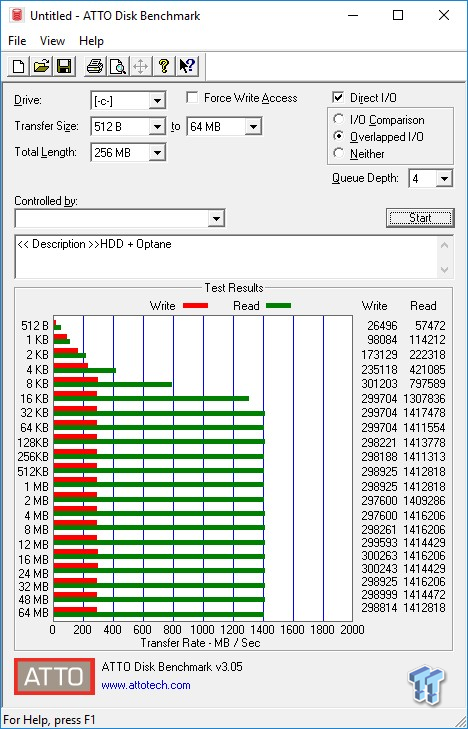
No problem meeting and exceeding Intel's sequential performance specs. We will point out that Optane Memory is able to achieve maximum sequential performance at smaller transfer sizes than we typically see from conventional flash-based SSDs. Optane Memory is hitting its max sequential write at 8KB transfers; max sequential read at 32KB transfers. Flash-based SSDs typically reach max sequential performance at between 128KB and 1MB transfer size.
Optane Memory running as a secondary storage device - Intel provided test system:
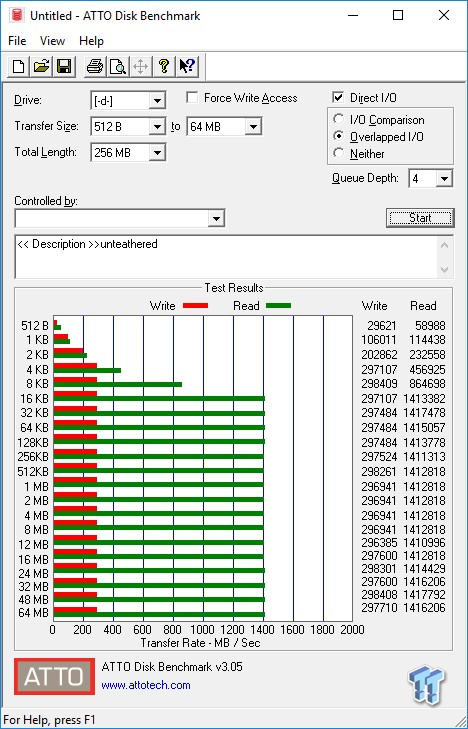
When we untether the Optane Memory module from the HDD and run it on its own as a secondary storage device, small file performance gets better. On its own, the Optane Memory module is hitting its max sequential write at 4KB transfers; max sequential read at 16KB transfers. Sequential write performance of the Optane Memory module is much lower than we typically see. However, when we get to our real-world performance testing, you will clearly see that as we've been saying for years' - sequential performance is not nearly as important as random performance in terms of system performance.
Optane Memory running as OS disk - TweakTown's high-performance Z270 test system:
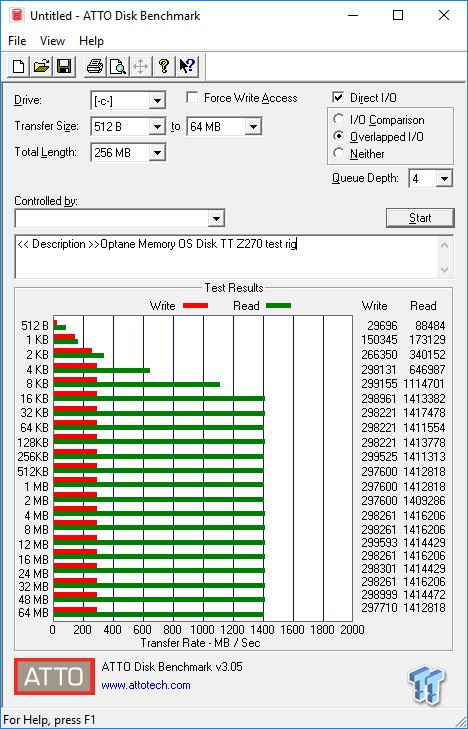
Our high-performance test system, as expected, cranks out even better small file performance than the Intel provided test system. On our system, we can almost hit max sequential write performance at 2KB transfers. This is astounding when you consider that a typical flash-based SSDs achieve max sequential write performance at about a 128KB or larger file size.
Anvil Storage Utilities
Version and / or Patch Used: 1.1.0
Anvil's Storage Utilities is a storage benchmark designed to measure the storage performance of SSDs. The Standard Storage Benchmark performs a series of tests; you can run a full test or just the read or write test, or you can run a single test, i.e. 4K QD16. When evaluating performance with Anvils, we focus on total score. With Optane Memory, we will focus on the total read score.
Mechanical HDD only - Intel provided test system:

As evidenced by the results of this test, a mechanical HDD on its own is not what you want for an OS disk. In an OS environment, random performance is what matters, and this is where a mechanical HDD is at its worst. This is why it takes 50 seconds to reboot to desktop with a typical mechanical HDD. To say that this performance is terrible is an understatement.
Mechanical HDD + Optane Memory - Intel provided test system:
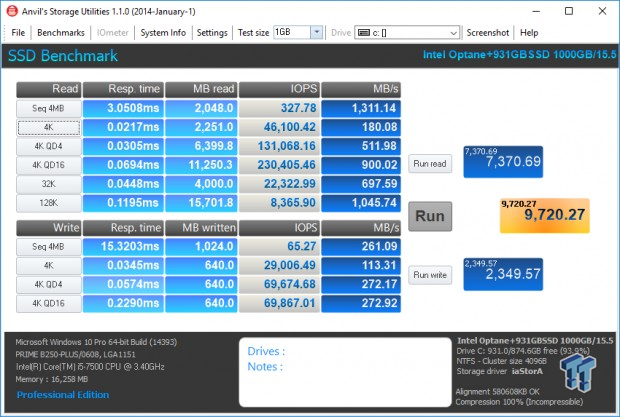
This particular test run gives us our first taste of Optane Memory's main strong point - random read performance. At 4K QD1 read, Optane Memory + HDD is delivering more than 3x the performance of the fastest NVMe SSD, and like we explained earlier, this is by far the most important performance metric in an OS environment. This metric is where system responsiveness comes from more than anywhere else. Already, we can see that 3D XPoint is a game changing technology. Even when tethered with a sluggish mechanical HDD, Optane Memory acceleration can deliver better system response than any flash-based NVMe SSD.
Let's focus on the total read score. A total read score of 7,370.69 with Windows 10 is a new lab record, and this is in spite of the low sequential read performance where 4MB sequential transfers are dragging the total score down. The previous lab record total read score comes from Samsung's $1,300 2TB 960 Pro which scored 6,898.34. We will also point out that the Optane Memory module delivers the best 128K sequential read performance we've seen from this test.
Optane Memory running as a secondary storage device - Intel provided test system:
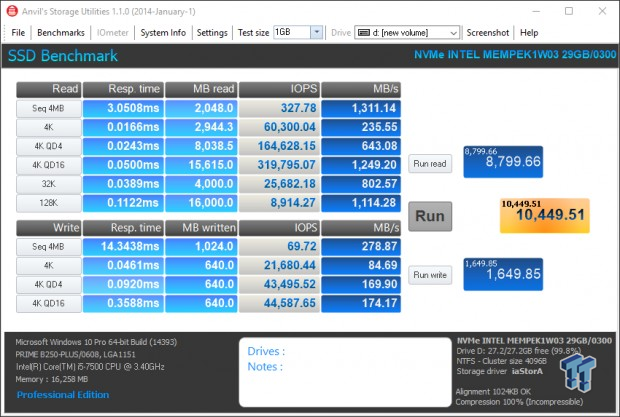
When we untether the Optane Memory module from the HDD and run it on its own as a secondary storage device, random read performance goes way up, and random write performance goes down. This appears to be a corner-case scenario that only occurs when running the drive as a secondary device while using the RST driver. Look at that 4K QD1 read performance. 60K IOPS is more than 4x higher than a 960 Pro is capable of. Random read performance at QD16 is 120K IOPS better than any flash-based NVMe SSD can deliver.
Optane Memory running as OS disk - TweakTown's high-performance Z270 test system:
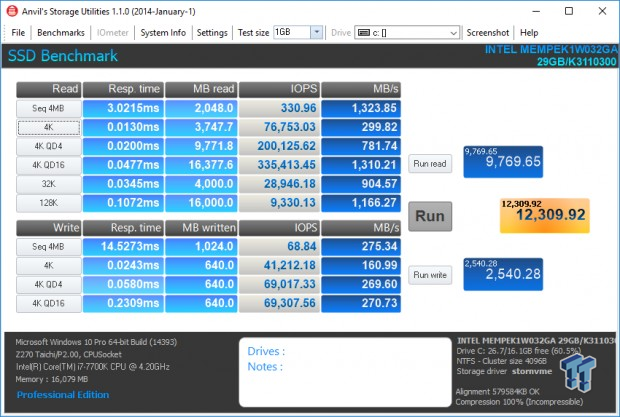
Our high-performance test system unleashes the Kraken. 76,753 IOPS at 4K QD1 is more than 5x better than a 960 Pro, and this is just scratching the surface of what the Optane memory module is capable of delivering under the right conditions. If we run Optane on a higher performing OS, we are able to hit up to 125,000 IOPS 4K QD1 read which is 8-9x better than any flash-based SSD. A total read score of 9,769.65 is over 3K better than the total read score of a 2TB 960 Pro. This is in spite of the fact that the Optane Memory module has relatively modest sequential read performance at 4MB sequential transfers dragging the total score down. We used the in-box Windows 10 NVMe driver for this test, and it did not suffer the same write performance decrease we witnessed with the RST driver and Optane memory running as a standalone secondary device.
Comparison performance - 960 Pro 2TB running as OS disk - TweakTown's high-performance Z170 test system:
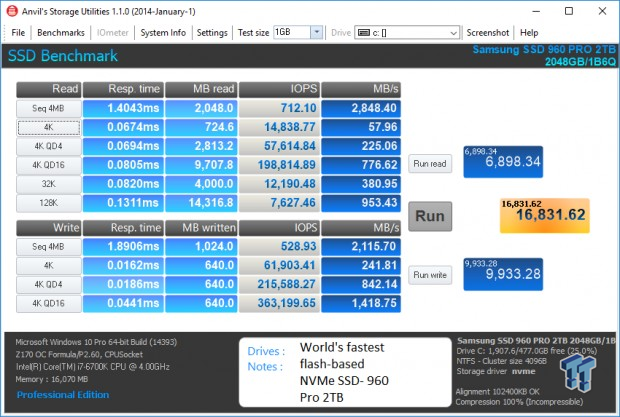
Our Anvil's testing seals the deal, proving beyond a shadow of a doubt that 3D XPoint does indeed, as Intel puts it, establish a new normal. Flash is no longer the go to for the ultimate in storage performance; it has now been relegated to a mid-performance storage tier.
As we previously mentioned, it is important to keep in mind that the Optane Memory module we are testing is only 32GB in capacity and still, it is absolutely demolishing the 2TB 960 Pro where it matters most - 4K QD1 random read. Even though the Optane Memory Module has very low write performance, this is more than offset by its mind-bending random read performance. Approximately 70% of the transactions that take place in an OS environment are random reads at QD1-4 which is why 3D XPoint has such an impact on system responsiveness.
Synthetic Benchmarks - CrystalDiskMark & AS SSD
CrystalDiskMark
Version and / or Patch Used: 3.0 Technical Preview
Mechanical HDD only - Intel provided test system:
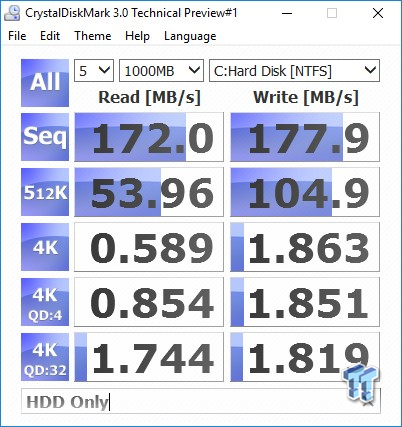
What we saw from our Anvil's testing applies here as well. An HDD on its own is as bad as it gets. Even USB pen drives can eviscerate the performance of a mechanical HDD. The only thing an HDD has going for it is cost per terabyte.
Mechanical HDD + Optane Memory - Intel provided test system:
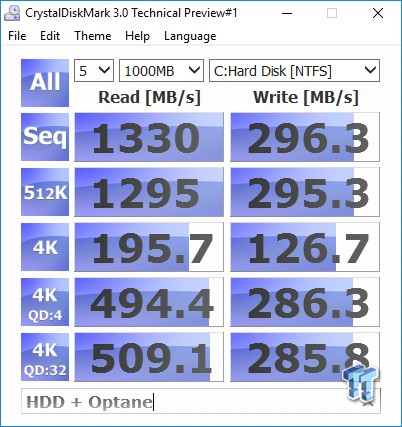
Optane Memory acceleration gives you the best of both worlds. Pairing Optane Memory with an HDD makes a world of difference, but you still do have to keep in mind that unless the data is cached by Optane, you will only be getting HDD type performance. Uncached performance will usually occur only once - the very first time you use a particular program. After that, Intel's intelligent caching software will recognize and accelerate everything that is commonly used.
Optane Memory running as a secondary storage device - Intel provided test system:
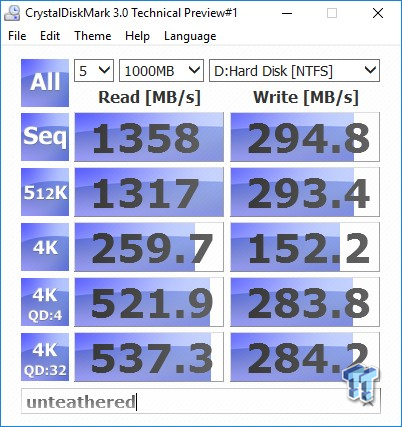
As the results show once again, the Optane Memory module is somewhat handicapped when tethered to a mechanical HDD. When we set it free, random performance shoots up significantly. Keep in mind that the Optane Memory module we are testing today, as fast as it is, only gives us a glimpse of the potential performance that 3D XPoint has to offer. This is because it is severely handicapped by the hardware configuration of the Optane Memory module itself. Imagine if you will, a full-blown Optane SSD with a more media die and a more powerful controller running on 4-lanes of Gen3 x4 PCIe. Later on, this year we won't have to imagine because it will be a reality.
Optane Memory running as OS disk - TweakTown's high-performance Z270 test system:
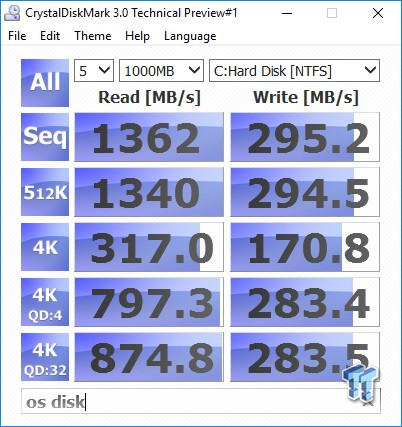
As we move over to our high-performance test system, random performance shoots up significantly. To put some perspective on the random read performance at QD1, 317 MBs 4K QD1 read translates to 81,152 IOPS. A 960 Pro at QD1 will deliver about 15,360 IOPS on this same version of CDM.
CDM version 5.2.1
We decided to include some CDM results with the latest version of CDM, because it is more commonly used to test storage performance. Again, we are primarily focused on 4K QD1 random read performance for the reasons we already stated.
Mechanical HDD + Optane Memory - Intel provided test system:

4K read = 209.8 MBs is equivalent to 53,708 IOPS
Optane Memory running as a secondary storage device - Intel provided test system:
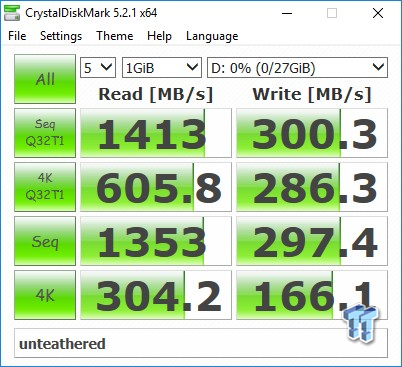
4K read = 304.2 MBs is equivalent to 77,875 IOPS
Optane Memory running as OS disk - TweakTown's high-performance Z270 test system:
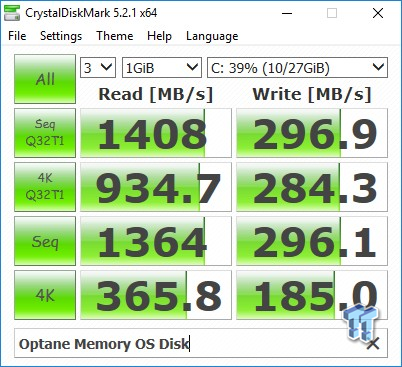
4K read = 365.8 MBs is equivalent to 93,645 IOPS. To put this in context, a 960 Pro running on this same test system gets 63MBs or 16,128 IOPS. This means that the 32GB Optane Memory module is delivering 5.8x the performance of a 2TB 960 Pro at 4K QD1 read.
AS SSD
Version and / or Patch Used: 1.8.5611.39791
AS SSD determines the performance of SSDs. The tool contains four synthetic as well as three practice tests. The synthetic tests are to determine the sequential and random read and write performance of the SSD. We evaluate AS SSD performance in terms of overall score. We are looking for a minimum score of 2,000 when evaluating NVMe SSDs.
We chose not to test with the HDD alone because it would take literally hours to run a complete an AS SSD test.
Mechanical HDD + Optane Memory - Intel provided test system:
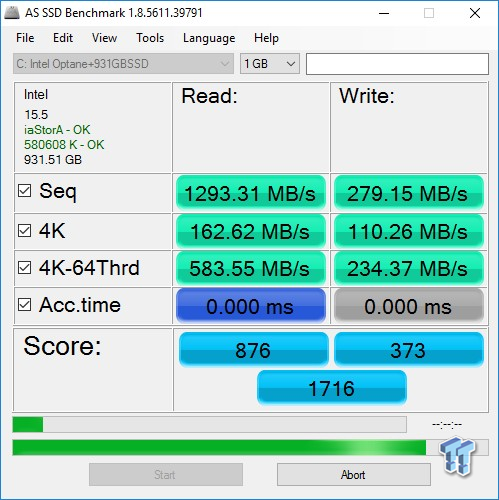
In terms of overall scoring, the Optane Memory Module is severely limited by its inherently low write performance and also because it is tethered to a Mechanical HDD. With this in mind, we will give it a pass for not meeting our minimum score of 2,000. We did not let the access times run in this configuration because AS SSD is accessing the HDD only and it would take at least a half hour to an hour just to get the access times, which would be useless anyway because it does not reflect the Optane Memory acceleration.
Optane Memory running as a secondary storage device - Intel provided test system:
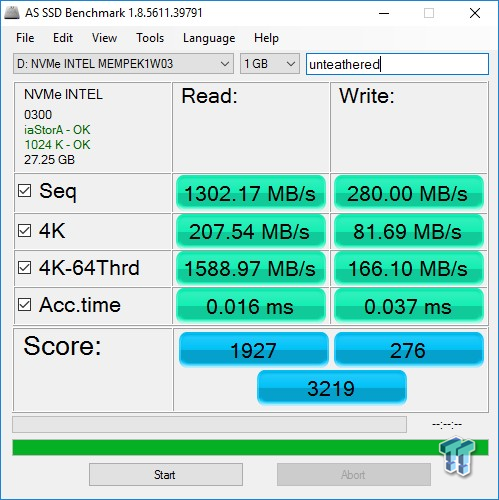
Untethered from the HDD, the Optane Memory module performs like a champ despite the low write performance that is inherent to any super-low capacity SSD. We see a decline in random write performance in comparison to HDD + Optane. This provides us with confirmation as to the reason behind this same decline in write performance we witnessed with Anvil's. When the Optane Memory module is running untethered on the RST driver, Windows write caching is disabled resulting in lower random write performance.
Optane Memory running as OS disk - TweakTown's high-performance Z270 test system:
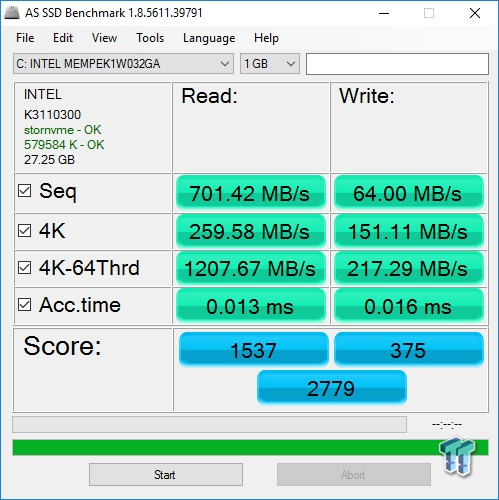
For reasons unknown, running Optane as our OS disk did not agree with AS SSD's data pattern. The overall score is still quite good despite the drop in sequential read/write performance. The 4K QD1 random read performance is a new lab record for AS SSD.
4K read = 259.58 MBs is equivalent to 66,452 IOPS
Benchmarks - Vantage, PCMark 7, PCMark 8 & SYSmark 2014 SE
Moderate Workload Model
We categorize these tests as indicative of a moderate workload environment.
PCMark Vantage - Hard Disk Tests
Version and / or Patch Used: 1.2.0.0
The reason we like PCMark Vantage is because the recorded traces are played back without system stops. What we see is the raw performance of the drive. This allows us to see a marked difference between scoring that other trace-based benchmarks do not exhibit. An example of a marked difference in scoring on the same drive would be empty vs. filled vs. steady state.
Mechanical HDD only - Intel provided test system:
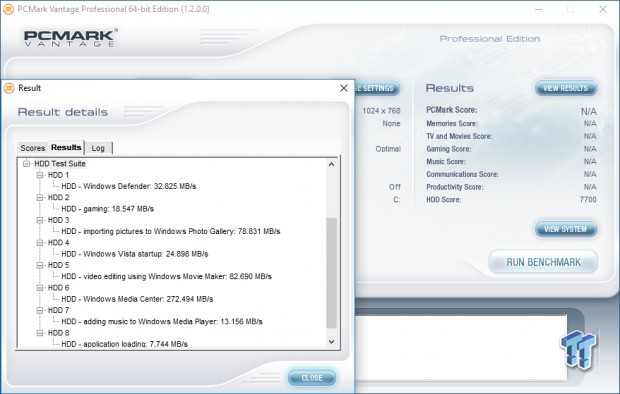
To say that this is a terrible score would be an understatement. A score of 7,700 is the lowest we've ever seen, probably because we've never run Vantage on a mechanical HDD. Take a look at the bandwidth at each phase of the test. Especially application loading. The bandwidth of application loading with the HDD alone is only 7.744 MBs. The results of this test clearly show that an HDD's workload performance is total garbage.
Mechanical HDD + Optane Memory - Intel provided test system:
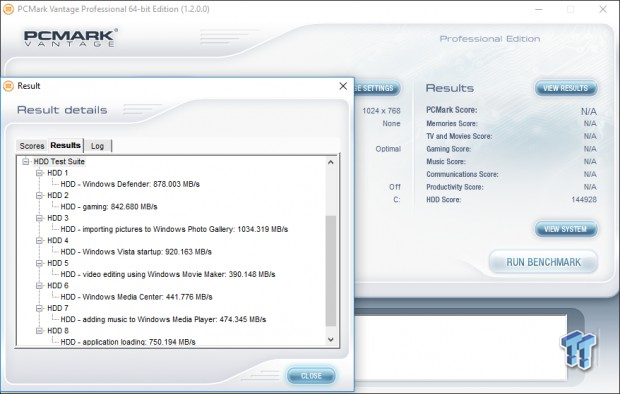
Pairing Optane Memory with an HDD makes for spectacular performance workload performance. We do need to mention that Vantage will need to be run twice for Intel's intelligent caching software to identify it as something to be accelerated. Our first run scored 9,500. the second run scored 144,928. Compared with the HDD alone, Optane caching is delivering a score that is 18.8x better. If we focus on application loading, Optane caching is delivering a whopping 100x the bandwidth of the HDD alone.
Optane Memory running as a secondary storage device - Intel provided test system:
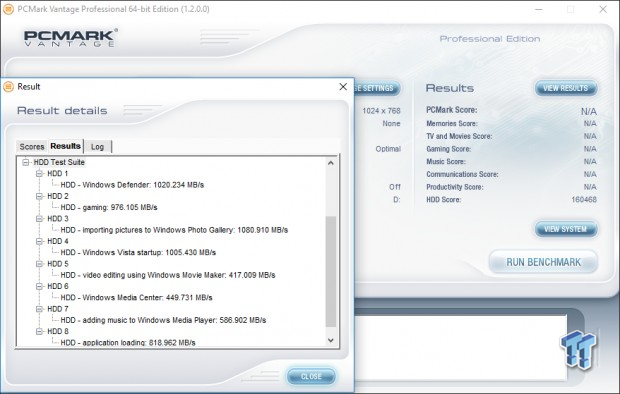
Untethering the Optane Memory module from the HDD doesn't net that much of a scoring increase. Vantage scoring is greatly impacted in a negative way when there is data on the disk. It is not uncommon to see a drive that scores 400,000 when empty drop down to as low as 80,000 when data is on the disk, so we are a bit surprised that the score did not go higher than 160K when the drive is empty.
Optane Memory running as OS disk - TweakTown's high-performance Z270 test system:
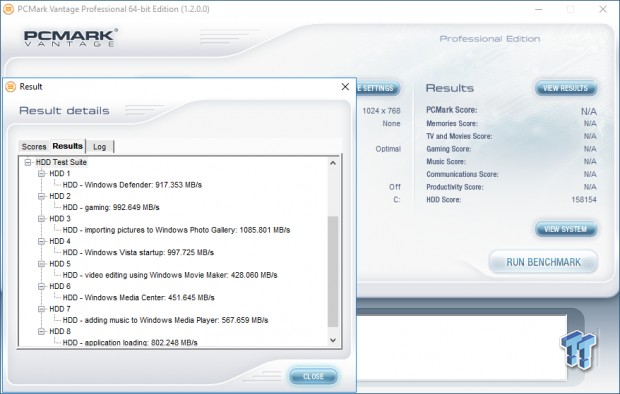
The Optane Memory module is our OS disk, and it is 75% filled with data. Despite this unfavorable scenario, the 32GB Optane Memory module delivers a new lab record for a 75% full OS Disk. Here is how it compares against the fastest flash-based NVMe SSDs:
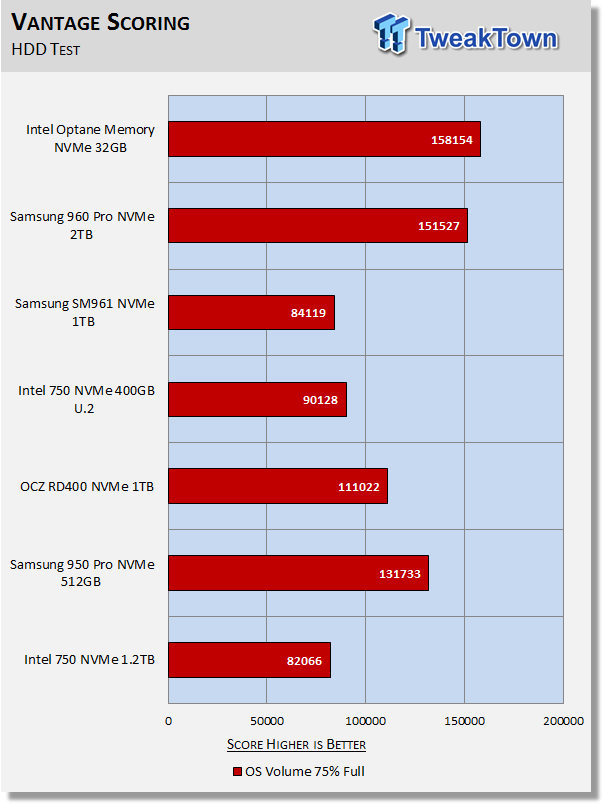
Despite all of the inherent disadvantages including capacity, interface, etc. the $77 32GB Optane Memory module is able to outperform the $1,300 2TB Samsung 960 Pro. This test shows clearly the impact low QD random read performance actually has on an OS environment. The Optane Memory module has the best 4K random read performance, so it scores highest.
PCMark 7 - System Storage
Version and / or Patch Used: 1.4.0
We will look to Raw System Storage scoring for evaluation because it's done without system stops and, therefore, allows us to see significant scoring differences between drives.
Mechanical HDD only - Intel provided test system:
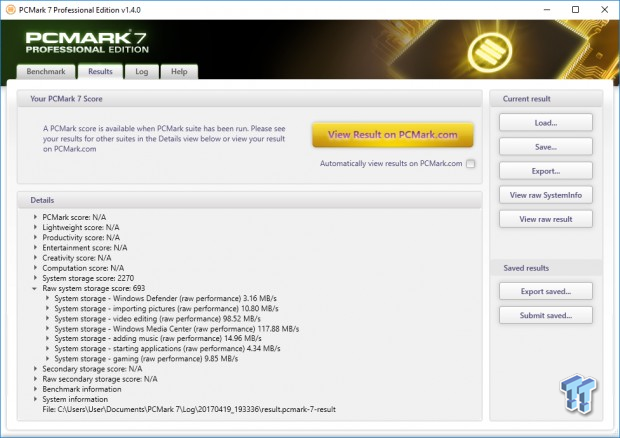
A raw system storage score of 693 is just abysmal. Starting applications has the HDD alone delivering an infinitesimally low bandwidth of 4.43 MBs. This is the first time we've ever run a HDD on PCMark 7. We knew it would be bad, but we did not anticipate it would be this horrible.
Mechanical HDD + Optane Memory - Intel provided test system:
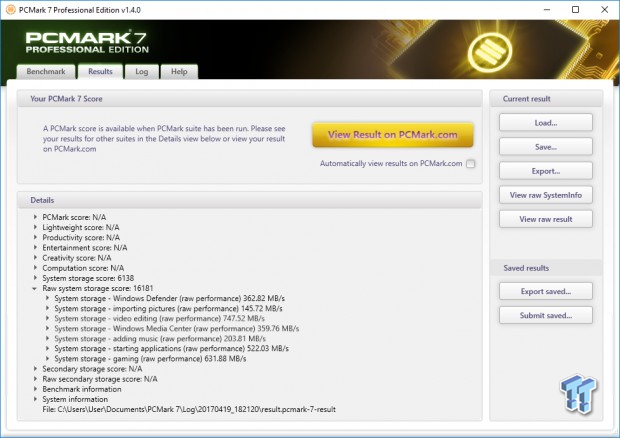
This time Intel's intelligent caching software was ready for the benchmark. We only had to run the test once to obtain a stellar result. With a score of 16,181 the Optane accelerated system delivered the third highest score in TweakTown history.
Optane Memory running as a secondary storage device - Intel provided test system:
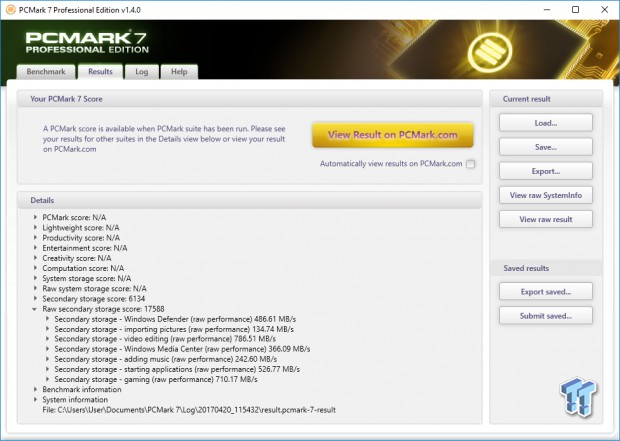
Untethering the Optane Memory module yields a substantial scoring increase. Untethered, the Intel Optane Memory module manages to unseat the 960 Pro 2TB as lab champion.
Optane Memory running as OS disk - TweakTown's high-performance Z270 test system:
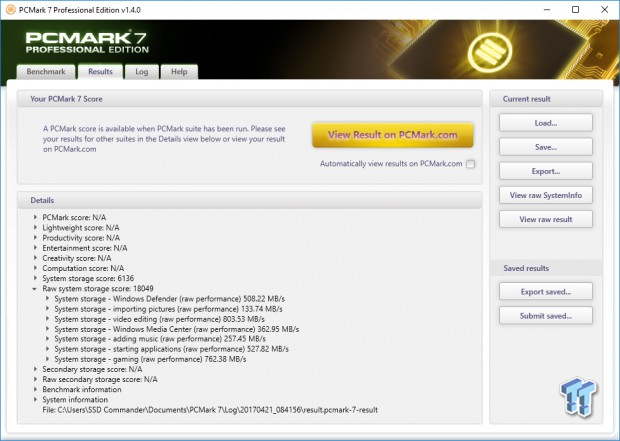
Unlike Vantage, PCMark 7 scoring is not negatively impacted when there is data on the disk. Running on our powerful test system, the Optane Memory module sets an all-time lab record for a single SSD by delivering an astonishing score of 18,409. Here is how it compares against the fastest flash-based NVMe SSDs:
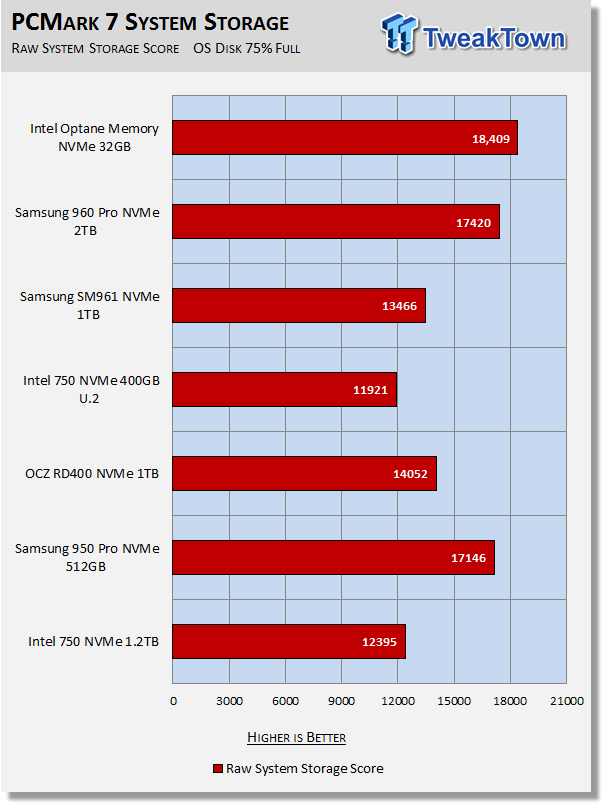
Despite all of the inherent disadvantages including capacity, interface, etc., the $77 32GB Optane Memory module once again outperforms the $1,300 2TB Samsung 960 Pro when running moderate consumer workloads.
PCMark 8 - Storage Bandwidth
Version and / or Patch Used: 2.4.304
We use PCMark 8 Storage benchmark to test the performance of SSDs, HDDs, and hybrid drives with traces recorded from Adobe Creative Suite, Microsoft Office, and a selection of popular games. You can test the system drive or any other recognized storage device, including local external drives. Unlike synthetic storage tests, the PCMark 8 Storage benchmark highlights real-world performance differences between storage devices.
Mechanical HDD only - Intel provided test system:
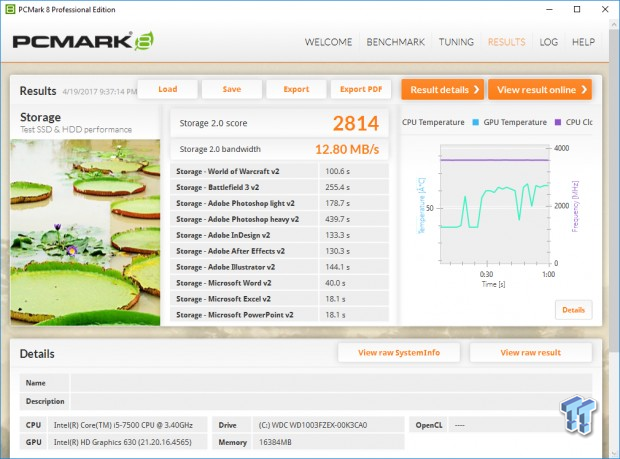
We always wondered what a mechanical HDD would do with this test, and now we know. A storage bandwidth of 12.8 MBs is just laughable.
Mechanical HDD + Optane Memory - Intel provided test system:
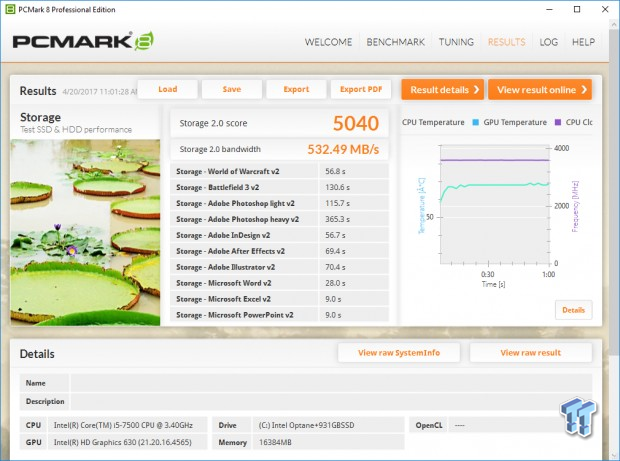
This result lands the Optane accelerated system's storage performance smack in the middle of the hyper-class flash-based NVMe SSDs. With Optane speeding things along, storage bandwidth is an astounding 41x higher than a standalone mechanical HDD.
Optane Memory running as a secondary storage device - Intel provided test system:
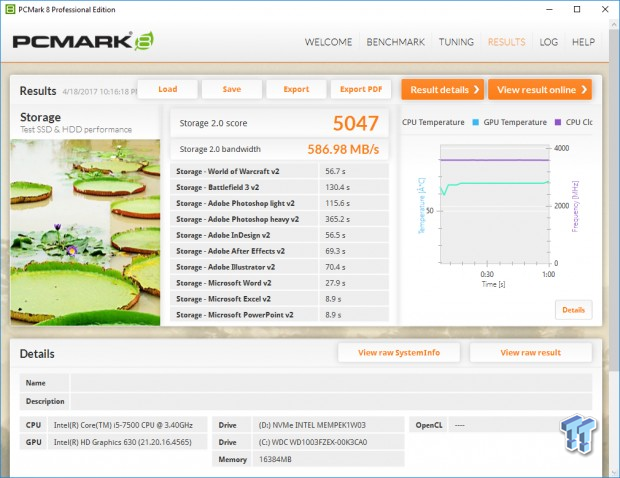
Untethering the Optane Memory module yields a substantial scoring increase. Untethered, the 32GB Intel Optane Memory module delivers a storage bandwidth of 586.98 MBs which has it nipping at the heels of OCZ's 1TB RD400.
Optane Memory running as OS disk - TweakTown's high-performance Z270 test system:
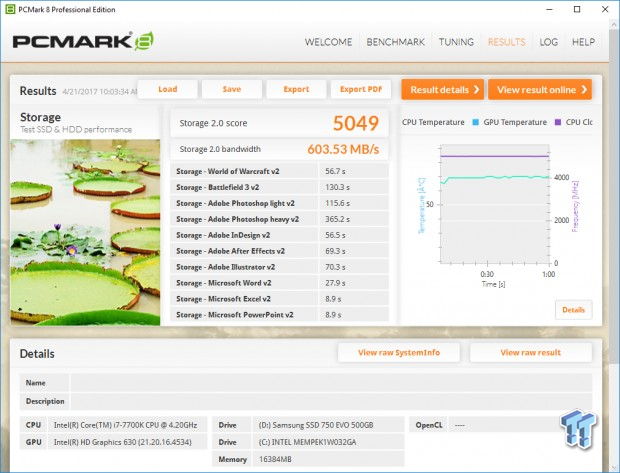
Unlike Vantage, PCMark 8 scoring is typically not negatively impacted in a significant manner when there is data on the disk. Running on our powerful test system, the Optane Memory module delivers a robust storage bandwidth of 603.53 MBs. We were hoping to see another lab record, but this time the diminutive Optane Memory Module couldn't get there. Here is how it compares against the fastest flash-based NVMe SSDs:
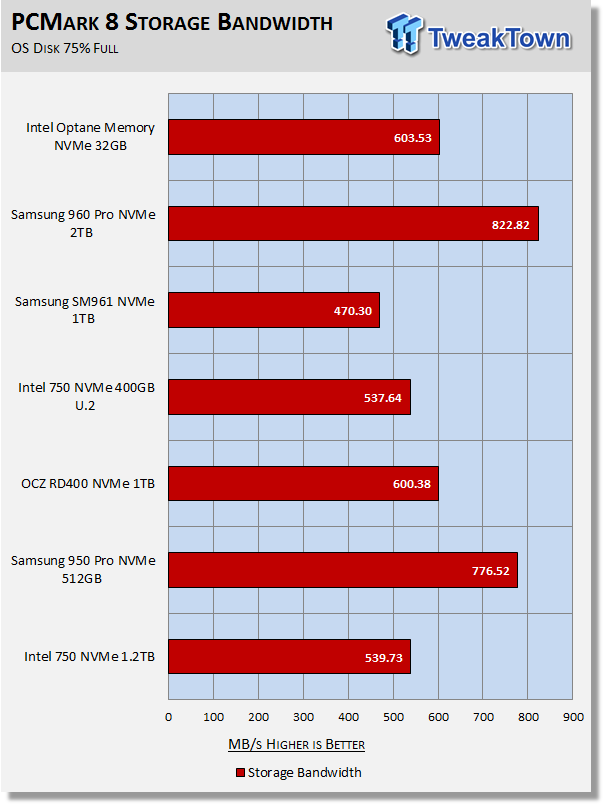
BAPCo SYSmark 2014 SE System Performance
Version and / or Patch Used: 2.0.0.70
SYSmark 2014 SE is considered the gold standard for testing system performance as a whole because it is an application based benchmark. This test gives us the ultimate in real-world results because it utilizes actual applications running on the system, instead of playing back recorded traces. If you want to know what kind of impact a system storage device will have on your system's overall performance; this test will show you. Disk performance has the greatest impact on the Responsiveness Score, so that is what we will focus on.
Mechanical HDD only - Intel provided test system:
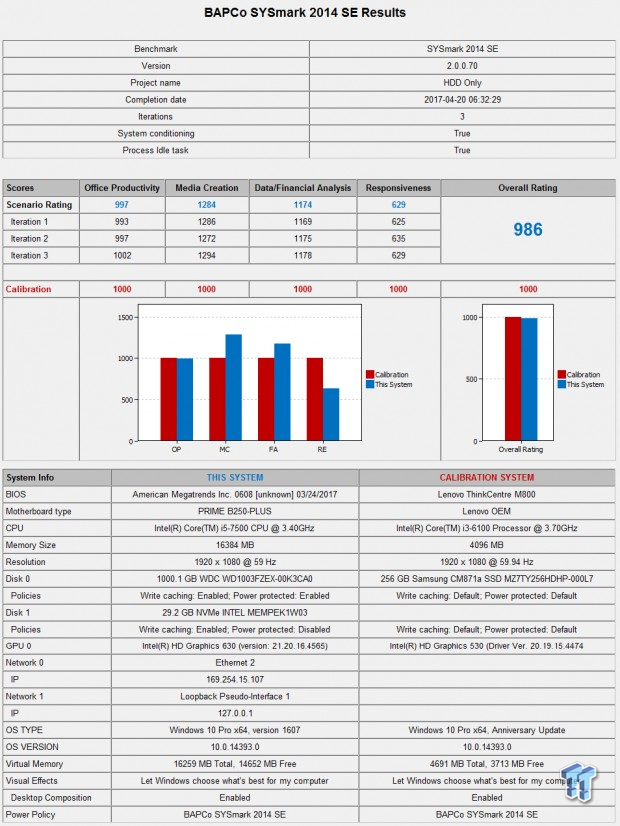
If we focus on the responsiveness score, we can see that the use of a mechanical HDD vs. an SSD has a huge impact. Despite the fact that the rest of our test system is providing a big boost over the calibration system, the HDD is dragging the overall score of our test system way down.
Mechanical HDD + Optane Memory - Intel provided test system:
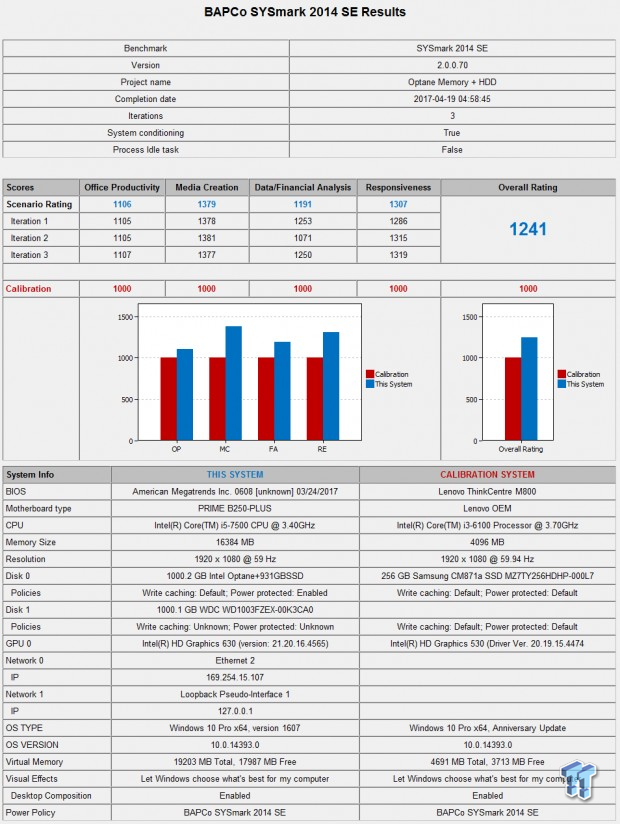
Pairing Optane Memory with the HDD gives the test system the boost it needs to deliver a decent overall score. When we focus on the responsiveness score, we can see that when Optane Memory is accelerating the system, it is overall nearly twice as responsive as an HDD alone.
We tried multiple times and spent many a frustrating hour trying to get SYSmark to run with the Optane Memory module alone. We believe we would have seen a new level of system performance delivered if it would work. However, with only 32GB (27GB after formatting) to work with there just isn't enough space for SYSMark to run on the Optane Memory module.
Benchmarks (Secondary) - Max IOPS & Disk Response
Iometer - Maximum IOPS
Version and / or Patch Used: Iometer 2014
We use Iometer to measure high queue depth IOPS performance.
Mechanical HDD only - Intel provided test system:
(Read IOPS at QD32 8GB addressable)
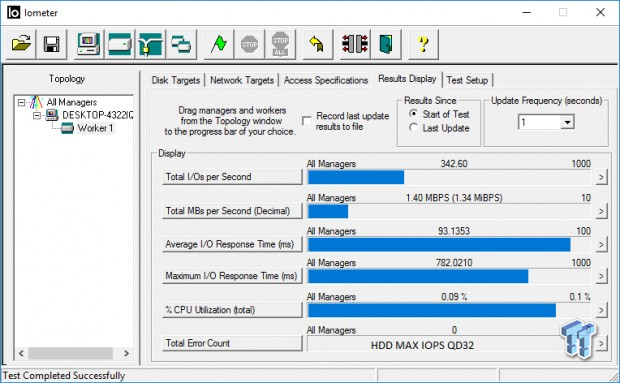
(Write IOPS at QD32 8GB addressable)
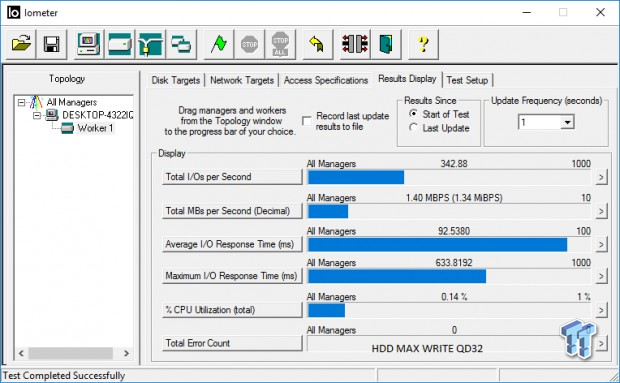
And there you have it. The maximum read/write IOPS this mechanical HDD can generate = 342 IOPS.
Optane Memory running as a secondary storage device - Intel provided test system:
(Read at QD16 8GB addressable)
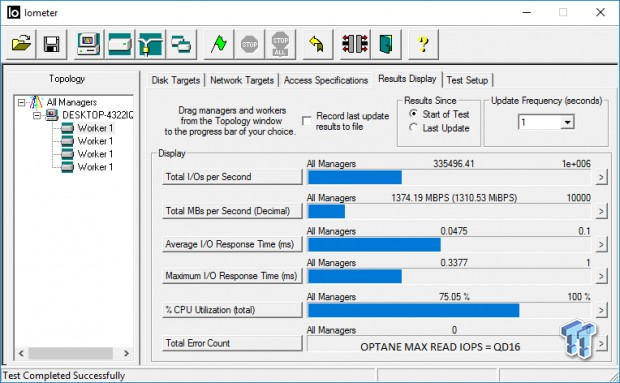
(Write at QD2 8GB addressable)
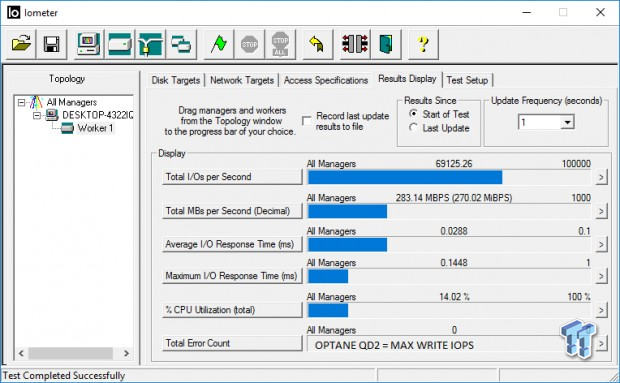
Typically we run this test on NVMe SSDs at QD256 to see what the max IOPS are at the highest feasible queue depth. With Optane Memory, there is no need to go that high in queue depth. We tested max read at QD 16 and got 335,000 IOPS. We tested max write at QD2 and got 69,000 IOPS.
Iometer - Disk Response
Version and / or Patch Used: Iometer 2014
We use Iometer to measure disk response times. Disk response times are measured at an industry accepted standard of 4K QD1 for both write and read. Each test runs twice for 30 seconds consecutively, with a 5-second ramp-up before each test. We partition the drive/array as a secondary device for this testing.
Mechanical HDD only - Intel provided test system:
(Write response at QD1 8GB addressable)
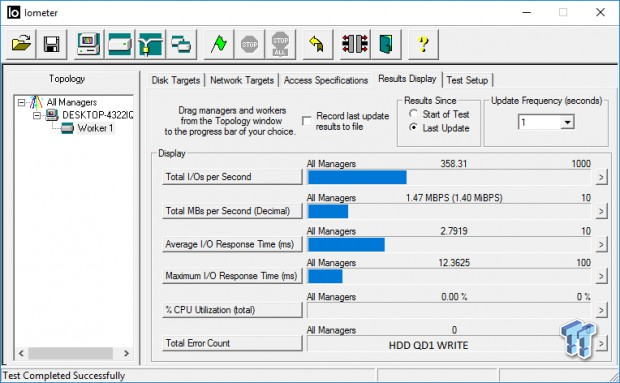
(Read response at QD1 8GB addressable)
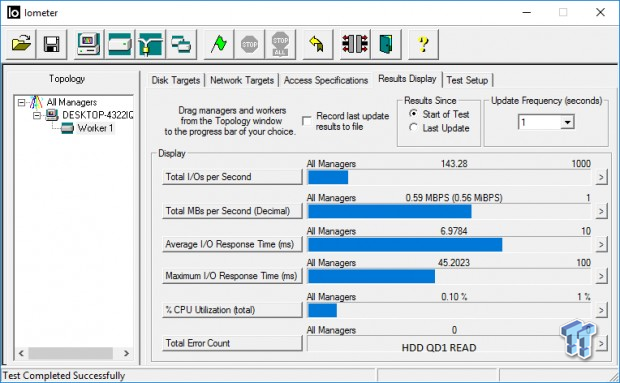
Optane Memory running as a secondary storage device - Intel provided test system:
(Write response at QD1 8GB addressable)
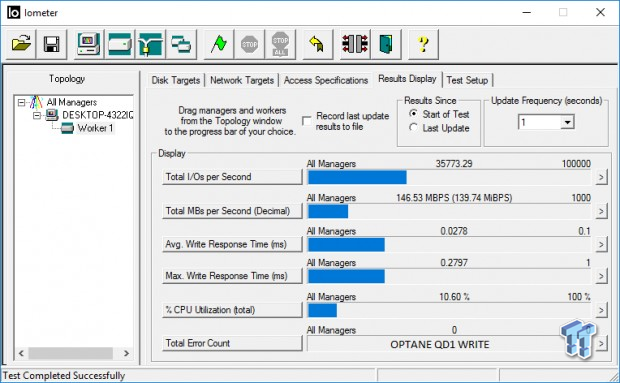
(Read response at QD1 8GB addressable)
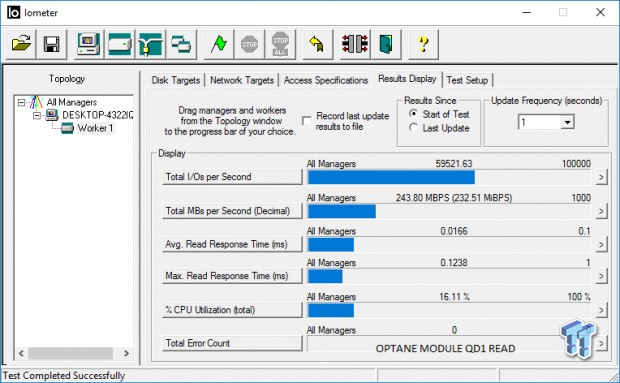
We won't waste our time going over the response times of the mechanical HDD. Instead, let's focus in on the read response (read latency at QD1) of the Optane Memory module running on its own. First, we need to take a look at the chart below:
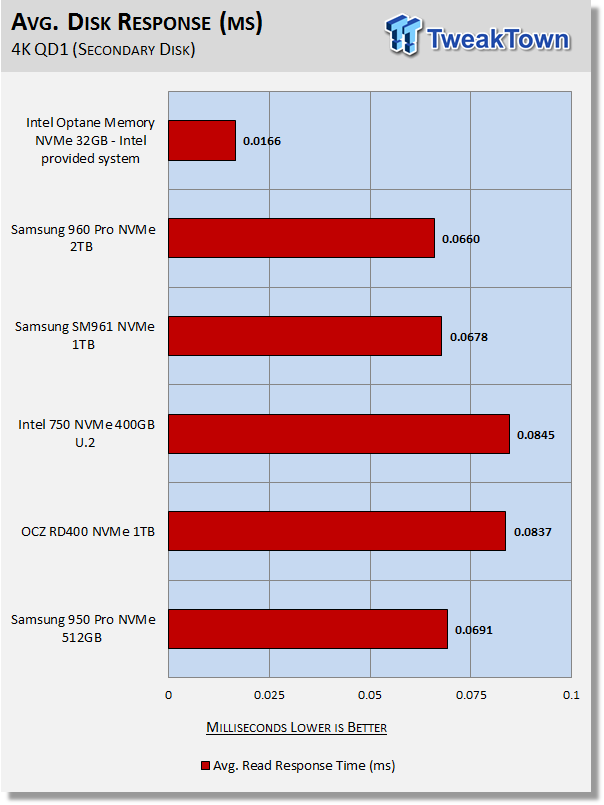
Lower is better, and Optane Memory running on the modest system provided by Intel has 4x lower (better) latency than the best NVMe SSD running on our high-performance Z170 test system. This, in a nutshell, is why 3D XPoint memory is a game changer.
Maxed-Out Performance (MOP)
We just wanted to briefly show that Optane Memory has even more horsepower under the hood when we run it on a faster OS than Windows 10. Let's once again focus on 4K QD1 random read performance.
Windows Server 2012 R2 running on Z270 with 7700K processor at 5GHz:
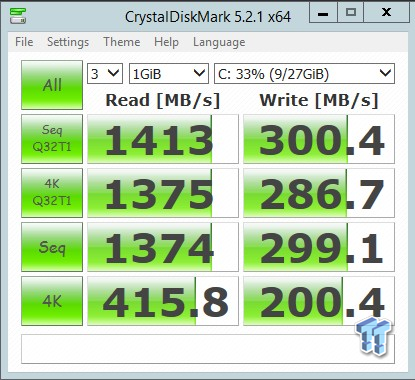
4K read = 415.8 MBs is equivalent to 106,445 IOPS
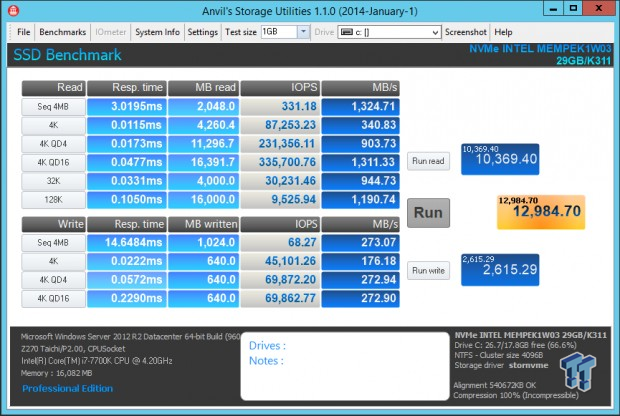
A total read score of 10,369.40 is a new lab record for any single SSD.
Windows Server 2008 R2 running on Z170 with 6700K processor at 4.7GHz:
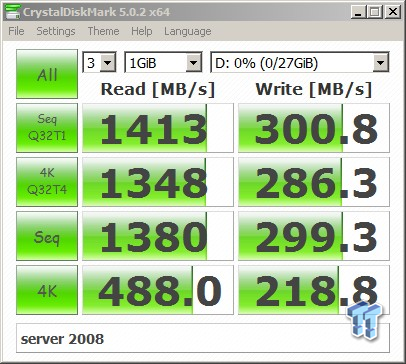
4K read = 488.0 MBs is equivalent to 124,928 IOPS. This is 7.5x the performance of a 960 Pro running on Server 2008.
Staggering 4K QD1 read performance to say the least.
Final Thoughts
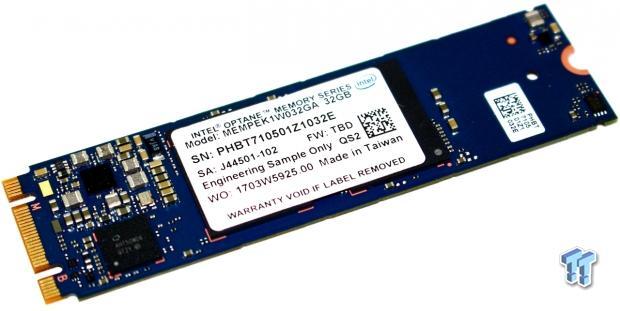
As we explained and demonstrated Ad nauseam throughout the entirety of this review, it's all about 4K random read performance at QD1-2 in an OS environment. This is the exact opposite of what people always focus on - sequential performance. We've been preaching this for years, but until now we didn't have something to really drive this fact home in the minds of our readers.
Sequential performance matters if you are transferring gigantic files from one SSD to another, but that's about the extent of the importance of sequential read/write. We are of the opinion that 99% of people that utilize solid state storage will be doing so with the system (OS) disk, where sequential performance is almost meaningless. Our message - quit looking at sequential performance and instead focus on low queue depth random read performance.
Who would have thought that just by adding a little 32GB Optane Memory module to cache an HDD you could actually get better system response in most scenarios than you will get from the best flash-based SSD? In reality, it is the most effective low cost storage solution devised to date. Optane Memory is changing the game, in a way that is likely to breathe new life (at least for few years) into the quickly fading mechanical HDD industry.
While we have found a reason not to hate HDD caching anymore, Optane Memory is so much more to us as enthusiasts. This tiny 32GB SSD has given us a glimpse into the near future, the new normal, where system performance is an order of magnitude better than anything we've experienced to date. And, keep in mind that for even better system performance you can use your Optane Memory module to accelerate SATA-based SSDs. We regret not having the time to test an Optane + SATA SSD configuration in time for this review, but we will do so in the near future.
Intel has been developing 3D XPoint for the past ten years, with a vision in mind to revolutionize computing as a whole and now that day is upon us, and we couldn't be more impressed with the outcome. Undoubtedly, other storage giants will follow suit with their own persistent memory technology, but as it stands today, Intel is the King of non-volatile storage performance.
Intel's 32GB Optane Memory Module SSD is TweakTown recommended.
Pros:
- Low QD Random Performance
- Low cost
- Best OS Performance
Cons:
- Low Capacity

